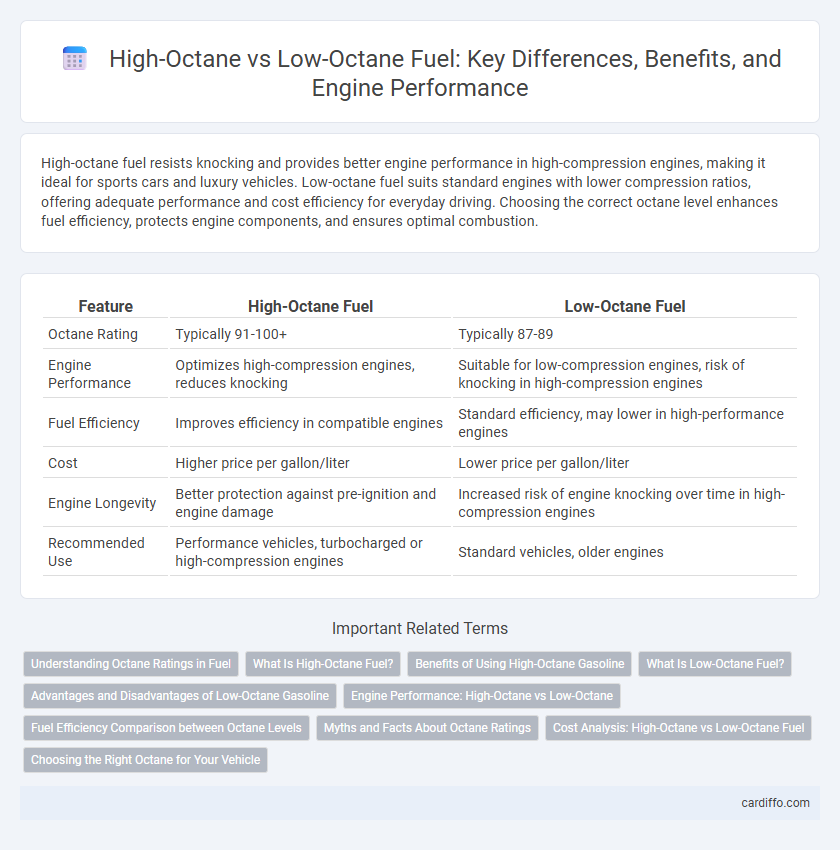High-octane fuel resists knocking and provides better engine performance in high-compression engines, making it ideal for sports cars and luxury vehicles. Low-octane fuel suits standard engines with lower compression ratios, offering adequate performance and cost efficiency for everyday driving. Choosing the correct octane level enhances fuel efficiency, protects engine components, and ensures optimal combustion.
Table of Comparison
| Feature | High-Octane Fuel | Low-Octane Fuel |
|---|---|---|
| Octane Rating | Typically 91-100+ | Typically 87-89 |
| Engine Performance | Optimizes high-compression engines, reduces knocking | Suitable for low-compression engines, risk of knocking in high-compression engines |
| Fuel Efficiency | Improves efficiency in compatible engines | Standard efficiency, may lower in high-performance engines |
| Cost | Higher price per gallon/liter | Lower price per gallon/liter |
| Engine Longevity | Better protection against pre-ignition and engine damage | Increased risk of engine knocking over time in high-compression engines |
| Recommended Use | Performance vehicles, turbocharged or high-compression engines | Standard vehicles, older engines |
Understanding Octane Ratings in Fuel
Octane ratings measure a fuel's ability to resist engine knocking during combustion, with high-octane fuels providing greater resistance than low-octane options. Engines designed for high-performance or turbocharged systems typically require high-octane fuel to optimize power output and prevent knocking, while standard engines generally operate efficiently on low-octane fuel. Choosing the appropriate octane rating ensures optimal engine performance, fuel efficiency, and longevity by matching the fuel's characteristics to the engine's compression requirements.
What Is High-Octane Fuel?
High-octane fuel contains a higher concentration of iso-octane, which enhances its ability to resist engine knocking and pre-detonation, making it ideal for high-performance and turbocharged engines. It typically has an octane rating of 91 or above, compared to low-octane fuel which ranges from 87 to 89. Using high-octane fuel can improve engine efficiency, power output, and longevity in vehicles designed for such specifications.
Benefits of Using High-Octane Gasoline
High-octane gasoline improves engine performance by resisting knocking and pre-ignition in high-compression engines, ensuring smoother power delivery and increased efficiency. It enhances fuel combustion, leading to better acceleration and potentially higher horsepower output. Using high-octane fuel also reduces engine wear, contributing to longer engine life and lower maintenance costs.
What Is Low-Octane Fuel?
Low-octane fuel typically has an octane rating below 87, indicating its lower resistance to engine knocking or pre-ignition. It is commonly used in standard gasoline engines designed for regular driving conditions and is often less expensive than high-octane fuel. Low-octane fuel can lead to reduced engine performance and efficiency in vehicles that require higher octane ratings for optimal operation.
Advantages and Disadvantages of Low-Octane Gasoline
Low-octane gasoline offers cost savings and better availability, making it suitable for standard engines designed for regular combustion requirements. However, it has lower resistance to knocking, which can reduce engine performance and efficiency in high-compression engines. Using low-octane fuel in vehicles requiring higher octane ratings risks engine damage and increased emissions due to incomplete combustion.
Engine Performance: High-Octane vs Low-Octane
High-octane fuel enhances engine performance by resisting knocking and allowing for more aggressive ignition timing, which maximizes power output and efficiency in high-compression engines. Low-octane fuel is more prone to causing engine knock, reducing optimal performance and potentially damaging engine components over time. Engines designed for high-octane fuel achieve smoother acceleration and better fuel economy compared to those running on low-octane alternatives.
Fuel Efficiency Comparison between Octane Levels
High-octane fuels, typically rated 91 or above, offer greater resistance to engine knocking, enabling more precise ignition timing and improved combustion efficiency in high-performance engines. Low-octane fuels, usually rated 87 or below, may cause knocking under high load, reducing fuel efficiency and potentially harming engine components. Vehicles designed for high-octane fuel achieve optimal miles per gallon (MPG) and lower emissions, while those designed for lower octane fuels often show marginally less efficient fuel consumption.
Myths and Facts About Octane Ratings
High-octane fuel is often misunderstood as a source of increased engine power, but its primary role is to prevent engine knocking in high-compression engines rather than boosting performance in standard engines. Low-octane fuel can cause knocking and reduced efficiency in engines designed for higher octane levels, leading to potential long-term damage. The correct octane rating enhances fuel combustion stability and engine longevity, debunking myths that higher octane always means better fuel quality or improved fuel economy.
Cost Analysis: High-Octane vs Low-Octane Fuel
High-octane fuel typically costs 20-50% more per gallon than low-octane options due to its refined composition and performance benefits. High-octane fuel improves engine efficiency and reduces knocking in high-compression engines, potentially saving on repair costs and extending engine life. Low-octane fuel is more economical upfront but may result in increased maintenance expenses and lower fuel efficiency for vehicles designed to run on higher octane ratings.
Choosing the Right Octane for Your Vehicle
Selecting the appropriate octane fuel depends on your vehicle's engine requirements, with high-octane fuel designed for high-performance engines to prevent knocking and low-octane suitable for standard engines ensuring efficient combustion. Using a higher octane than recommended does not improve performance or fuel economy but protects engines prone to knocking under heavy load or high compression. Refer to your vehicle's manufacturer guidelines to optimize engine efficiency, minimize emissions, and avoid potential engine damage by matching fuel octane accurately.
High-Octane vs Low-Octane Infographic

 cardiffo.com
cardiffo.com